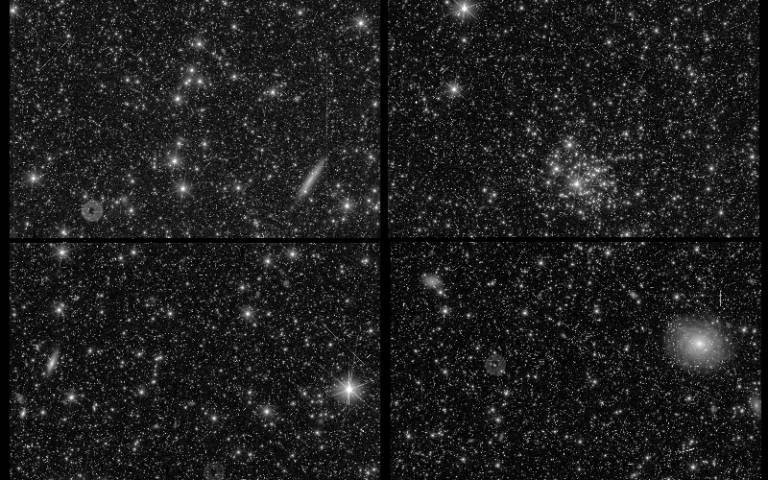First-light images from Euclid-VIS
31 July 2023
The European Space Agency released the first images taken by the Euclid space telescope’s VIS instrument, which was built by an international team led by UCL’s Mullard Space Science Laboratory.

The black and white engineering images depict stars, star clusters and galaxies, captured by the array of 36 visible light detectors in the VIS camera. Their sharp focus indicates the successful commissioning of the spacecraft’s instruments.
They have been released as raw images taken directly from the instrument’s data and with minimal processing. While these images already depict the distant universe in sharp focus, future releases will contain even more detail as the data is further refined. In addition to the starfield and galaxies, there are also visible streaks from where cosmic ray particles hit the detectors and which will also be removed with further processing.
Professor Mark Cropper (UCL Mullard Space Science Laboratory), lead for VIS, said: “Looking at these images, I’m thrilled by their beauty and the abundance of information in them. I’m so proud of what the VIS Team has achieved and grateful to all of those who have enabled this capability. VIS images will be available for all to use, whether for scientific or other purposes. They will belong to everybody.”
The Euclid mission will use VIS, short for the VISible instrument, and the Near-Infrared Spectrometer and Photometer (NISP) to study Dark Matter and Dark Energy in the universe. NISP also released its initial images.
Euclid was launched from Cape Canaveral on 1 July, and it has been travelling to reach its operational orbit around the second Lagrangian point, about four times the distance of the Earth to the Moon. This transit time has been used to commission Euclid, check out its communications, power and positioning systems, and bring online its two data-collection cameras, VIS and NISP.
Once fully operational, Euclid will use VIS and NISP to survey the shapes of galaxies and map the geometry of the Universe with the aim of making accurate measurements of mysterious Dark Matter and Dark Energy, which make up most of the cosmos. No one yet knows what Dark Matter and Dark Energy is, but their influences can be sees on the visible universe, and Euclid will be a powerful tool to understand it.
Professor Andrew Fazakerley (UCL Space & Climate Physics), Director of UCL's Mullard Space Science Laboratory, said: “I am very happy to see that even the early engineering image from Euclid-VIS are of such high quality. This has been one of the most challenging projects we have ever undertaken.
"Looking forward, a team of MSSL experts will support the operation of the VIS instrument in flight, and MSSL scientists will play a leading role in the Consortium that will analyse the data from VIS. Remarkably, MSSL has now had major roles on two of the largest scientific imagers flown in space, on Gaia and Euclid, and we are also deeply involved in work on a third, to be flown on the PLATO exoplanet mission.”
Over its six-year mission, Euclid will map in extremely high resolution the third of the sky where the distant universe is visible. It will be the full segment that is neither obscured by the stars and dust of the Milky Way nor subject to the scattered light from the dust in our own Solar System. It is a huge area of sky to be covered, so the instruments have wide fields of view, but can take finely detailed images to measure the shapes of galaxies.
The images will be processed by the Euclid Consortium, an association of more than 2,000 scientists and engineers from across Europe, North America and Japan, and of which the VIS and NISP teams are part. This complex and rigorous analysis will reveal the structure of Dark Matter in much of the universe and the influence of Dark Energy over time.
Large-scale supercomputers will compare this behaviour with theoretical models and isolate the nature of these “Dark” components of the Universe. In addition, astronomers will use the huge resource of Euclid in many other investigations to take forward our understanding of the space we live in.
Caroline Harper, head of Space Science at the UK Space Agency, said: “It’s fantastic to see these early commissioning images returned from Euclid, demonstrating that it is on track in its mission to map the dark Universe, and that the UK-led visible imager has successfully survived the journey into space. These images mark a milestone moment for the many people around the world who have been working on the development and launch of Euclid for years.
"The UK Space Agency’s contributions will enable Euclid to bring us new insights into both dark matter and dark energy, helping the global science community build a clearer picture of the origin and evolution of the Universe and the way it is expanding.”
"The UCL team provided the system-level role, and produced, tested and calibrated the twelve electronics and power supply units along with their associated CCDs, for the 36 detector array, to ensure they survive and operate as intended in the cold environment of space."
VIS has been funded by the UK Space Agency, and those of France, Italy and Switzerland, and has benefitted from support from the Euclid Consortium and from close cooperation with ESA.
Links
- ESA official announcement
- Professor Mark Cropper's academic profile
- UCL News Feature about Euclid
- UCL Mullard Space Science Laboratory
- UCL Space & Climate Physics
- UCL Mathematical & Physical Sciences
- ESA Euclid Mission
Image
- The first Euclid image exhibits stars, star clusters and galaxies. All stars have six spikes from diffraction effects in the telescope, though these are evident here only for the bright ones.
There are also streaks from particles which hit the detectors having travelled through space. - Image credit: ESA
Media Contact
Mike Lucibella
- E: m.lucibella [at] ucl.ac.uk
 Close
Close

